
Soft-close drawers provide a smooth, quiet closing experience by using a damping mechanism to prevent slamming, while standard drawers rely on manual force, often resulting in noise and potential wear over time. Understanding the benefits of soft-close technology can help you make an informed choice for your cabinetry--explore the rest of the article to learn more.
Table of Comparison
| Feature | Soft-Close Drawer | Standard Drawer |
|---|---|---|
| Closing Mechanism | Controlled, quiet, cushioned close | Manual close, often noisy |
| Durability | Reduces wear and tear on drawer and frame | More prone to damage from slamming |
| Safety | Prevents fingers from getting caught | Higher risk of finger injuries |
| Cost | Higher initial cost | Lower cost |
| Maintenance | Requires minimal maintenance | May need frequent adjustments |
| User Experience | Smooth, quiet, enhanced convenience | Basic functionality |
Introduction to Drawer Mechanisms
Soft-close drawer mechanisms use advanced hydraulic or pneumatic dampers to gently slow drawer movement, preventing slamming and reducing noise. Standard drawers typically rely on basic sliding rails without any damping, resulting in a louder and more abrupt close. Your choice impacts the overall user experience, cabinet longevity, and daily convenience.
What is a Soft-Close Drawer?
A soft-close drawer features a specialized mechanism that slows the drawer's movement as it closes, preventing it from slamming shut and reducing noise and wear. Unlike standard drawers that rely on manual force and simple slides, soft-close drawers use hydraulic dampers or springs for controlled, gentle closing. Your furniture benefits from enhanced durability and a quieter environment with soft-close technology.
What is a Standard Drawer?
A standard drawer is a basic storage compartment featuring traditional mechanical slides that allow for manual opening and closing without specialized dampening technology. These drawers typically rely on friction or basic rollers, which means they may close with noise or require extra force to shut properly. Unlike soft-close drawers, standard drawers do not have built-in mechanisms to prevent slamming or provide smooth and controlled closing.
Key Features of Soft-Close Drawers
Soft-close drawers feature a hydraulic damping mechanism that ensures drawers close quietly and smoothly, preventing slamming and reducing wear and tear. They often include anti-slip mats or buffers to secure contents, enhancing overall durability and user safety. These drawers also offer controlled closing speed and noise reduction, making them ideal for modern kitchens and offices seeking both functionality and comfort.
Advantages of Standard Drawers
Standard drawers offer simplicity and cost-effectiveness, making them an economical choice for budget-conscious homeowners. Their straightforward mechanism requires minimal maintenance, reducing long-term repair expenses. Additionally, standard drawers provide reliable functionality with easily replaceable parts, ensuring durability in everyday use.
Noise and Safety Comparison
Soft-close drawers significantly reduce noise by using hydraulic dampers that slow the drawer's closing, preventing the loud slamming common with standard drawers. This mechanism enhances safety by minimizing the risk of finger injuries often caused by abrupt closures. Your kitchen or workspace benefits from both quieter operation and increased protection for users, especially children.
Durability and Maintenance
Soft-close drawers feature advanced damping mechanisms that reduce impact and wear, resulting in greater durability compared to standard drawers with basic slides. The controlled closing motion minimizes stress on drawer components, decreasing the frequency of repairs and maintenance. Standard drawers, with less sophisticated hardware, tend to experience faster wear and require more frequent adjustments or replacements over time.
Cost Differences
Soft-close drawers generally cost 20-40% more than standard drawers due to the specialized damping mechanisms and enhanced hardware required. Installation expenses can also rise by $50 to $100 per drawer, reflecting the complexity of fitting soft-close systems. Despite higher upfront costs, soft-close drawers reduce wear and tear, potentially lowering long-term maintenance expenses compared to standard drawers.
Installation and Compatibility
Soft-close drawers require precise alignment during installation to ensure the damping mechanism functions smoothly, often necessitating compatible hardware and mounting systems designed for soft-close features. Standard drawers offer easier installation with more universal compatibility across various cabinet types and hardware, requiring fewer adjustments. Compatibility of soft-close drawer slides depends on cabinet thickness and side-clearance specifications, whereas standard drawers typically accommodate a broader range of dimensions without specialized components.
Which Drawer Type is Best for You?
Soft-close drawers prevent slamming by using hydraulic or pneumatic mechanisms, providing a quieter, smoother closing experience that reduces wear and tear. Standard drawers rely on manual force to close and tend to be less expensive but may cause noise and quicker deterioration over time. Your choice depends on whether you prioritize durability and noise reduction or cost-effectiveness and simplicity in your cabinetry.
 homyna.com
homyna.com